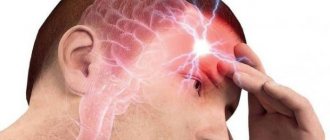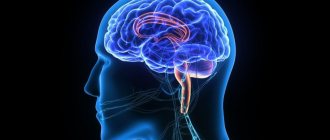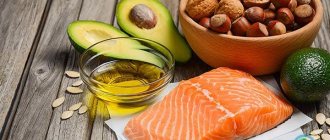The concept of vegetative-vascular dystonia (VSD) includes a whole range of symptoms. The patient’s complaints are not specific; it is difficult to say in which system the violation occurred and which disease causes certain manifestations. If we evaluate the symptoms comprehensively, then they are not characteristic of any other pathology.
Most modern doctors agree that VSD does not exist - it is a pseudo-diagnosis that requires a more careful and thorough examination of the patient. It is important to establish and eliminate the underlying disease, then the symptoms of vegetative-vascular dystonia will gradually disappear.
What is the autonomic nervous system (ANS)
The autonomic or autonomic nervous system (NS) in the human body is responsible for the functioning of the endocrine glands, organs, lymphatic and circulatory systems. Stable operation of the ANS is constant homeostasis, a person’s ability to adapt to environmental changes.
The autonomic nervous system consists of two sections with opposing functions:
- Sympathetic NS. The department is responsible for increasing the strength and intensity of heart contractions, for narrowing blood vessels, for inhibiting gastrointestinal motility, for inhibiting the digestive and salivary glands, for increasing ventilation of the lungs, and for relaxing the sphincters of the bladder.
- Parasympathetic NS. Excitation in this part of the nervous system leads to bradycardia, excessive release of enzymes in the gastrointestinal tract, spontaneous compression of the bladder sphincter, shortness of breath, constriction of the pupils, and increased salivation. Parasympathetic nervous system has virtually no effect on the condition of blood vessels, with the exception of dilatation of the coronary, pulmonary arteries, arteries of the brain and genital organs.
In a healthy person, both parts of the nervous system balance each other. The body adequately adapts to changes in its own condition and in the environment. When there is a violation of the coordination between the sympathetic and parasympathetic departments, vegetative-vascular dystonia develops.
Exercise therapy for neurocirculatory dystonia
Physical therapy for hypotonic dystonia plays an important role in complex treatment. It helps to better tolerate physical and mental stress, increase the tone of the body, and strengthen it overall.
It is necessary to engage in physical exercise without overwork, several times a day for 10 to 15 minutes (necessarily after meals). At first it is better to do this under the supervision of a specialist, and then you can do it at home.
To select a set of exercises, you need to seek help from a doctor, and only after his prescriptions begin to perform the exercises.
Types of VSD
There is no generally accepted classification of the disease. Depending on the prevalence of the symptom complex, three forms of vegetative-vascular dystonia are distinguished:
- Local. The complaints are isolated, the violations are mild.
- Systemic. The disorder affects only one organ system.
- Generalized. The patient has many different complaints, dysfunction of several systems and organs is observed.
According to the severity of symptoms, VSD can be mild, moderate and severe.
According to the nature of the course, permanent (constant), latent (hidden) and paroxysmal (paroxysmal) vegetative-vascular dystonia are distinguished.
Due to the development of the disorder, the pathology is primary, caused by the anatomy and physique of the patient, and secondary, caused by the disease.
Based on the level of blood pressure, VSD is divided into hypotonic, hypertonic and mixed types.
Reasons for development
No matter how trivial it may sound, neurocirculatory dystonia of the hypotonic type can often begin with a common nervous disorder. It is caused by numerous factors (stress at work and at home, numerous tragic events with loved ones, financial instability, etc.).
But not everyone who is exposed to nervous tension suffers from VSD. There are reasons for the development of the disease, the concomitance of which with nervous disorders can cause hypotonic dystonia. This:
- Genetic disposition. The disease can be inherited (through the female line, but there are exceptions).
- Abuse of alcoholic beverages and smoking, as well as refusal of an active lifestyle.
- Weakening of the autonomic system due to chronic infectious diseases.
- Pinched nerves, injuries, after which the blood supply to certain areas of the central nervous system (CNS) has deteriorated.
- Hormonal disorders.
The causes of the disease can be observed in adults (most often women, but there are cases of the disease in men). Children are also susceptible to this disease.
Symptoms of the disease
Several years ago, doctors diagnosed a patient with VSD if they did not find any significant pathology and could not determine a more accurate diagnosis. Now medicine knows that dozens of diseases can be hidden behind vegetative-vascular dystonia. The list of possible symptoms is very wide.
Most often, patients complain of the following types of disorders:
- From the cardiovascular system: heart rhythm disturbances, a feeling of tightness or pain in the chest, increased or decreased blood pressure, sweating, cold palms. Patients report sudden flashes of heat or cold, conditions close to fainting.
- From the respiratory system: feeling of lack of air, lump in the throat. A person cannot breathe deeply.
- From the nervous system: headaches, insomnia, involuntary twitching of the arms and legs, dizziness in a stuffy room. If a person sits or lies for a long time, then if he stands up suddenly, his vision may become dark.
- From the gastrointestinal tract: nausea, loss of appetite, constipation or diarrhea, abdominal pain for no apparent reason. Particularly impressionable patients may develop vomiting and anorexia due to panic.
- From the genitourinary system: erectile dysfunction, urinary disorders. In men, vegetative-vascular dystonia may be accompanied by prostate enlargement. In this case, the infectious agent is not detected. In women, problems in the autonomic nervous system provoke disruption of the menstrual cycle.
- From the emotional state: almost every patient with VSD has mental disorders. A person is constantly tense, excited, not restrained, or, conversely, becomes lethargic and apathetic. Chronic lack of sleep can create fears, cause panic attacks, and weaken memory and attention. Adult men and women often arrive at the doctor's office already feeling very emotionally exhausted. In most cases, psychological instability is not a sign of illness and can be easily corrected by working with specialists.
Despite the fact that there is no diagnosis of VSD in the ICD, the complex of disorders itself is quite common. According to medical statistics, about 80% of the world's population have at least once experienced symptoms of vegetative-vascular dystonia. The disorder occurs not only in adults, but also in adolescents and young people aged 20-30 years.
Diagnosis of vegetative-vascular dystonia
Depending on the prevalence of certain symptoms, it is necessary to undergo examination by a cardiologist, neurologist, therapist or endocrinologist. Often consultations with several specialists are required. Diagnostics is carried out comprehensively.
The patient may be prescribed:
- Electrocardiogram (ECG) to exclude heart pathologies.
- An electroencephalogram (EEG) to evaluate the functioning of different areas of the brain.
- Magnetic resonance imaging (MRI) of a specific area or part of the body to study in detail the internal tissues and structures.
- Ultrasound examination (ultrasound) of organs and blood vessels.
- General and biochemical blood and urine tests.
Based on the examination results, the doctor determines further tactics for working with the patient. For example, if problems with the gastrointestinal tract are detected, endoscopy or intubation may be required. If cancer is suspected, a biopsy, etc. is performed.
The main difficulty in diagnosing VSD is the late visit to the doctor. Patients ignore the first symptoms of the disease or try to cope with them on their own. Over time, the manifestations intensify and complications develop. The sooner the patient comes for diagnosis, the faster and easier the treatment. Don't delay visiting the doctor.
How to treat VSD of the hypotonic type
If manifestations of hypotonic VSD are detected, you should immediately consult a doctor to determine an accurate diagnosis. A late visit to the doctor or an advanced disease can lead to the development of complications. If, after a full examination, you are diagnosed with vegetative-vascular dystonia, you must immediately begin treatment.
Treatment of VSD of the hypotonic type consists of complex drug treatment together with traditional medicine. The main purposes include:
- Antidepressant therapy improves sleep, increases appetite, and relieves emotional stress.
- Sedatives have a calming effect and stabilize sleep.
- Nootropic drugs stimulate brain function.
- Tranquilizers. These pills reduce anxiety and agitation.
- Antipsychotics treat mental disorders.
Taking vitamins for hypotonic type VSD of groups A, E, B and C has a beneficial effect on the body.
Treatment of VSD
Drug treatment
Drug therapy is selected taking into account the patient’s specific complaints and the results of his examination. The doctor may prescribe medications:
- increasing or decreasing blood pressure;
- normalizing heart rate;
- eliminating headaches and insomnia;
- promoting active digestion, etc.
Treatment of vegetative-vascular dystonia in women may include taking hormonal medications if the cause of poor health is an imbalance in the body or cycle disorders.
Psychotherapy
An important role in the treatment of vegetative-vascular dystonia is played by stabilization of the patient’s psycho-emotional background. The doctor prescribes complex therapy for the underlying disease and may refer the patient to a consultation with a clinical psychologist. If VSD manifests itself in a mild form, dysfunction of the autonomic nervous system can be eliminated by simple lifestyle changes. The patient is advised to avoid stress, walk more, and get enough sleep. If necessary, mild sedatives of herbal origin are prescribed.
Physiotherapy
A course of procedures helps restore the tone of blood vessels, normalize metabolism, relieve inflammation and reduce pain. The frequency and duration of sessions are selected individually.
For the treatment of VSD use:
- laser therapy;
- magnetic therapy;
- inductometry with darsonvalization;
- electrophoresis with electrosleep.
Massage with acupuncture has a positive effect. During the session, the patient relaxes, the feeling of anxiety goes away, and stress subsides. Acupuncture should be performed by an experienced reflexologist. Using thin needles, he stimulates biologically active points on the human body. In addition to activating blood circulation and reducing muscle spasms, acupuncture promotes the production of cortisol and serotonin - hormones that directly affect a person’s emotional state.
Diet therapy
There is no special diet for the treatment of VSD. If the disease is accompanied by poor digestion or pathology of the gastrointestinal tract, the doctor will prescribe an appropriate menu. In other cases, patients are advised to adhere to the principles of proper nutrition. It is worth limiting the consumption of salt, smoked, fatty foods, fried foods, and fast food. You should not overeat at night so that an overfilled stomach does not affect your sleep. Preference is given to products rich in magnesium and calcium.
It is important to understand that vegetative-vascular dystonia is not a disease, but a symptom complex that may indicate incipient health problems. The peculiarity of the disorder is that the coordinated work of the doctor and the patient can significantly weaken the manifestations of the pathology or get rid of it altogether.
Classic massage for VSD
Today, treatment methods for hypotonic dystonia are not limited to taking medications. In addition to drug treatment, doctors recommend exercise therapy, exercises and massage. But the specialist is obliged to carefully monitor the patient’s condition during the procedure, act carefully, and sometimes it is better to start a massage for VSD of the hypotonic type (classic) only after the patient’s condition improves after drug therapy.
For this disease, it is advisable to use classical massage for the back, pelvic area, legs and abdominal area (10 - 15 sessions). The massage should begin gradually, lightly stroking the desired area, and only after that proceed to intensive actions. In this case, it is necessary to take into account the lymph flow (direction). Massage strengthens blood vessels, promotes blood flow to necessary parts of the body and organs, and improves the functioning of the nervous system.
Prevention of vegetative-vascular dystonia
The doctor will help eliminate the cause and manifestations of the disease, but only the patient himself can take care of maintaining his health.
During the period of remission, you must adhere to the basic rules:
- Walk more, move, play sports to the best of your ability.
- Eat fractionally and regularly in small portions.
- Include seasonal fruits, vegetables, and berries in the menu.
- Give up bad habits, including drinking strong tea and coffee.
- Have an annual medical examination.
- Treat any diseases in a timely manner.
- Avoid stressful situations.
Diet for hypotonic dystonia
Proper nutrition has always been considered the key to good health. There is no need to stuff your body with strong coffee in the morning; it is better to drink a glass of clean water after waking up in small sips to improve your appetite. After the body absorbs water, food will be absorbed much better.
For quality nutrition, it is better to focus on fruits, vegetables, cereals and legumes, and it is also recommended to drink green tea or a drink made from dried fruits. They will provide your body with a complex of essential vitamins and microelements that will strengthen the body during hypotonic VSD.
The food products of a patient with VSD must contain magnesium and potassium. It is advisable to exclude flour, sweets and spicy foods.








